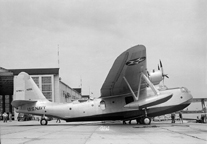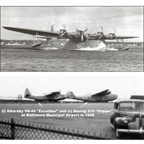November, 1937

Sikorsky VS-44 (XPBS-1) "Flying Dreadnought"
Model Airplane News Cover Art for November, 1937
by Jo Kotula
Click to Enlarge
After failing to convince the Navy of its merits as a "flying dreadnought", this giant four-engined flying boat was adapted for the trans-Atlantic passenger market, with a capacity of 40+ passengers. Only three aircraft, designated VS-44, were produced: Excalibur, Excambian, and Exeter.


Photos of the Sikorsky VS-44 (XPBS-1) "Flying Dreadnought"
Click to Enlarge
In 1935, the new Consolidated YP3Y-1 (prototype for the famous PBY Catalina had just flown, promising the Navy a long range patrol and rescue craft that was second to none. Even so, the Navy was making plans for a new patrol bomber that would have even greater range, speed and weapon load capability. Prototypes were ordered from Sikorsky in June 1935 and Consolidated Aircraft in July 1936. The Sikorsky entry (XPBS-1) made its first flight in September of 1937, the Consolidated entry (XPB2Y-1) flew in December of the same year. However, the U.S. Navy did not have funds at that time to procure either aircraft. However, 15 months later the contract was given to Consolidated who produced the Coronado. Cut out of the military market, Sikorsky sold the XPBS-1 design to civilian customers as the VS-44.
However, the military had not completely lost interest. The XPBS-1 was evaluated by the National Advisory Committee for Aeronautics (NACA) in 1938. In 1939 XPBS-1 was temporarily operated by Patrol Wing Five at Norfolk, Virginia; then by Patrol Wing Two at Pearl Harbor, Hawaii, until it was finally assigned to transport squadron VR-2 at Naval Air Station Alameda, in 1940. Finally, on June 30, 1942, the XPBS-1 met with tragedy. The "sweep boats" of the Alameda naval Air Station failed to detect a submerged log floating in the landing zone. The large flying boat hit the log at about 70 mph and flipped over. Among its passengers was CINCPAC Admiral Chester W. Nimitz who suffered minor injuries, while one member of the flight crew, Lt. Thomas M. Roscoe, died. The XPBS-1 sank and was lost. Admiral Nimitz was to have two more "incidents" with flying boats, surviving them all, and going on to lead the US to victory in the Pacific and then have a Freeway named after him.
The Sikorsky commercial version (VS-44) was 30 mph faster and could fly 500 miles further than the competing Boeing 314 "China Clipper", earning bragging rights as having the longest full-payload range of any aircraft in the world. The VS-44 brought home several new world records after it went into operation, but war clouds dimmed the prospects for long range commercial aviation, especially to the Orent. American Export Airlines (AEA) ordered three VS-44s, dubbed ‘Flying Aces’ and named Excalibur, Excambian, and Exeter. AEA had grown out ofa steamship line, so naturally these planes gave nothing away to cruise ships. Sikorsky’s standard of luxury boasted full-length beds, dressing rooms, full galley, snack bar, lounge and fully controlled ventilation. Unforunately this limited production run would never even recoup the VS-44’s development costs.
The outbreak of World War II put civilian transatlantic air services on hold. Now under a Navy contract, with the Navy designation JR2S-1, AEA’s three VS-44’s continued flying between New York, New York and Foynes, Ireland, carrying passengers, freight and war materiel. The first VS-44, Excalibur, crashed on takeoff in 1942 at Botwood, Newfoundland, killing 11 of the 37 aboard. After the war, the two remaining VS-44s continued to fly for AEA, now renamed American Overseas Airlines (AOA) and operated by American Airlines. In 1949, AOA sold Excambian to Tampico Airlines. In 1946, Exeter was sold to TACI of Montevideo, Uruguay, as CX-AIR. It crashed on August 15, 1947 while landing in River Plate off Montevideo when (allegedly) returning from a smuggling flight to Paraguayan rebels. 4 out of the 5 crew were killed, but both passengers survived.
A short-lived effort to restore the only remaining VS-44 to run freight in the Amazon was unsuccessful, leaving the flying boat boat stranded in Ancon Harbor, Peru. By the late 1950s, two Southern California businessmen had heard of the Excambian's plight and had her ferried to Long Beach, where restoration work began. Excambian carried thousands of passengers between Los Angeles and Catalina Island until 1967 when it was sold to Charles Blair of Antilles Air Boats. Blair acquired Excambian to ferry passengers among the Virgin Islands. In January of 1969 she was extensively damaged by rocks while taxiing at Charlotte Amalie, US Virgin Islands. Assessed as being damaged beyond economic repair, it was beached in March 1972 and converted into a hot dog stand. In 1976, Excambian was donated to the Naval Aviation Museum at Pensacola, Florida and eventually put on permanent loan to the New England Air Museum in Connecticut where it was restored to its post-World War II American Export Airlines livery with volunteer help from some of the former Sikorsky workers who had built the original VS-44
Here is a video of the Sikorsky VS-44:
Click Here for more information about the Sikorsky VS-44 (XPBS-1) "Flying Dreadnought".

Click to go back and select another cover.
Counter for the Entire Site (not just this page..)
Home | About Lindy | Last Week's Reviews | Upcoming Events | 1940s Collecibles
The Guide - Establishments - Travel - Accessories
Music | Links | Photo Gallery | Extras | Contact